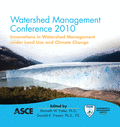Evaluating Effectiveness of Best Management Practices to Control Accelerated Sedimentation of the Morro Bay Estuary
Publication: Watershed Management 2010: Innovations in Watershed Management under Land Use and Climate Change
Abstract
The Morro Bay estuary, located on the central Coast of California approximately half way between Los Angeles and San Francisco, is one of the most important wetlands on the west Coast as it supports wide variety of habitats including numerous sensitive and endangered plant and animal species. Various studies have identified accelerated erosion and subsequent sedimentation as a major threat for sustainability of the bay. Watershed disturbances caused by agricultural activities are believed to be one of the major causes of the accelerated erosion and sedimentation. More than 200 conservation practices have been installed in the watershed since the mid-1990 to reduce erosion and sedimentation. This paper will review the implemented BMPs and will evaluate effectiveness of the BMPs using observations and modeling exercise. Streamflow and sediment concentration, measured mainly during the rainy seasons, are available for multiple locations in the watershed. However, the observations are not sufficient in terms of spatial density and data length to evaluate effectiveness of the mitigation measures at various locations in the watershed. It would be daunting in terms of cost to develop an intensive network of monitoring sites that would be needed for reliable management of NPS pollutants. As a result, comprehensive watershed simulation models that integrate watershed and climate characteristics and can estimate pollutant quantity at various locations, and that can also identify source of the contaminants, is emerging as a key component of watershed management. In this regard, a comprehensive watershed simulation model for the Morro Bay watershed has been developed using Soil and Water Assessment Tool (SWAT) to simulate both streamflow and sediment concentration. The observed data was used to improve prediction accuracy of the SWAT model through parameter sensitivity analysis and calibration steps. Parameter sensitivity analysis was performed using step-wise-regression analysis and Morris's one-at-a time (OAT) method. Calibration was performed using four different optimization methods: PEST, Genetic Algorithms, the Shuffled Complex Evolution Algorithm, and Dynamically Dimensioned Search. Relative performance of the sensitivity analysis methods and the calibration algorithms will be discussed in terms of effectiveness and computational efficiency. The developed model was used to evaluate effectiveness of the BMPs implemented in the Morro Bay watershed, and can also be used to prioritize sites where BMPs may be implemented in the future to further improve ecological integrity of the estuary.
Get full access to this article
View all available purchase options and get full access to this chapter.
Information & Authors
Information
Published In
Copyright
© 2010 American Society of Civil Engineers.
History
Published online: Apr 26, 2012
ASCE Technical Topics:
- Analysis (by type)
- Bays
- Best Management Practices (BMPs)
- Coastal engineering
- Coasts, oceans, ports, and waterways engineering
- Engineering fundamentals
- Environmental engineering
- Erosion
- Estuaries
- Geology
- Geotechnical engineering
- River engineering
- River systems
- Sediment
- Sensitivity analysis
- Shores
- Stormwater management
- Water and water resources
- Water treatment
- Watersheds
- Wetlands (coastal)
Authors
Metrics & Citations
Metrics
Citations
Download citation
If you have the appropriate software installed, you can download article citation data to the citation manager of your choice. Simply select your manager software from the list below and click Download.
